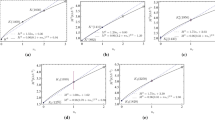Summary
The photon momentum dependence is brought into photon-vector-meson coupling strengths by taking account of the contribution of the intermediate quark-antiquark state. The data on cross-sections for photoproductions and leptonic widths of vector mesons, cross-sections for ψ production by off-shell photons and the pion form factor can be reproduced simultaneously by using the coupling strengths with the photon momentum dependence.
Riassunto
Si introduce una dipendenza dell’impulso del fotone nelle ampiezze dell’accoppiamento fotone-mesone vettoriale tenendo conto del contributo dello stato intermedio quark-antiquark. I dati sulle sezioni d’urto per la fotoproduzione e le ampiezze leptoniche dei mesoni vettoriali, le sezioni d’urto per la produzione di ψ mediante fotoni all’esterno dello strato e il fattore di forma del pione si possono riprodurre simultaneamente mediante le ampiezze di accoppiamento con la dipendenza dall’impulso del fotone.
Similar content being viewed by others
References
J. J. Sakurai:Currents and Mesons (Chicago, Ill., 1969).
A. Donnachie andG. Shaw, Editors:Electromagnetic Interactions of Hadrons (New York, N. Y., 1978).
M. Gell-Mann andF. Zachariasen:Phys. Rev.,124, 953 (1961).
K. Okada:Prog. Theor. Phys.,41, 1376 (1969);43, 1574 (1970).
P. G. O. Freund:Nuovo Cimento A,44, 411 (1966).
M. Gell-Mann, D. Sharp andW. Wagner:Phys. Rev. Lett.,8, 261 (1962).
K. Okada:Prog. Theor. Phys.,43, 566 (1970).
G. McClellan, N. Mistry, P. Mostek, H. Ogren, A. Osborne, J. Swartz, R. Talman andG. Diambrini-Palazzi:Phys. Rev. Lett.,26, 1593 (1971).
G. J. Gounaris andJ. J. Sakurai:Phys. Rev. Lett.,21, 244 (1968).
F. M. Rennard:Nucl. Phys. B,15, 267 (1970).
S. Okubo:Prog. Theor. Phys.,64, 583 (1980).
T. Bauer andD. R. Yennie:Phys. Lett. B,60, 165 (1976).
H. J. Behrend, F. Lobkowicz, E. H. Thorndike andA. A. Wehmann:Phys. Rev. Lett.,24, 336 (1970).
U. Camerini, J. G. Learned, R. Prepost, C. M. Spencer, D. E. Weiser, W. W. Ash, R. L. Anderson, D. M. Ritson, D. J. Sherden andC. K. Sinclair:Phys. Rev. Lett.,35, 483 (1975);R. L. Anderson, W. W. Ash, D. B. Gustavson, T. Reichelt, D. M. Ritson, D. J. Sherden, C. K. Sinclair, U. Camerini, J. G. Learned, R. Prepost andD. E. Weiser:Phys. Rev. Lett.,36, 263 (1977).
K. Terasaki:Lett. Nuovo Cimento,31, 458 (1981).
It is known (1,16) that to the ordere theem 2v f v prescription is equivalent to the gauge-invariant interaction of hadrons compatible with the current-field identity.
N. M. Kroll, T. D. Lee andB. Zumino:Phys. Rev.,157, 1376 (1967).
E. M. Lifshitz andL. P. Pitaevskii:Relativistic Quantum Theory, translated byJ. B. Sykes andJ. S. Bell (London, 1974), p. 424.
P. L. Braccini, C. Bradaschia, R. Castaldi, L. Foa, K. Lübelsmeyer andD. Schmitz:Nucl. Phys. B,24, 173 (1970).
The signs of theX v(0) are chosen to be compatible with those from the naive quark charge counting.
Particle Data Group:Rev. Mod. Phys.,52, 1 (1980) (Part II).
G. Flügge: Internal Report DESY PLUTO 80/01 (1980).
The European Muon Collaboration:Phys. Lett. B,89, 267 (1980).
C. J. Bebek, C. N. Brown, M. Herzlinger, S. D. Holmes, C. A. Lichtenstein, F. M. Pipkin, S. Raither andL. K. Sisterson:Phys. Rev. D,13, 25 (1976).
In a colour gauge theory like QCD (23)S. Weinberg:Phys. Rev. Lett.,31, 494 (1973); the symmetry of flavour is broken only through the quark mass differences. Therefore, we assume the symmetry of flavour for dimensionless constants. Besides, in this type of theories, the effective interactions are relatively stronger at long distances, while they are weaker at short distances. For this property of the strong interactions, even the deviations from the symmetry in parameters with the dimension of mass at low momentum squared will be smaller than the mass breaking due to gluon corrections.
S. Weinberg:Phys. Rev. Lett.,31, 494 (1973);D. J. Gross andF. Wilczek:Phys. Rev. D,8, 2633 (1973).
Author information
Authors and Affiliations
Additional information
To speed up publication, the author of this paper has agreed to not receive the proofs for correction.
Rights and permissions
About this article
Cite this article
Terasaki, K. Vector-meson dominance with photon-vector-meson coupling strengths dependent on the photon momentum squared. Nuov Cim A 66, 475–484 (1981). https://doi.org/10.1007/BF02730368
Received:
Published:
Issue Date:
DOI: https://doi.org/10.1007/BF02730368



